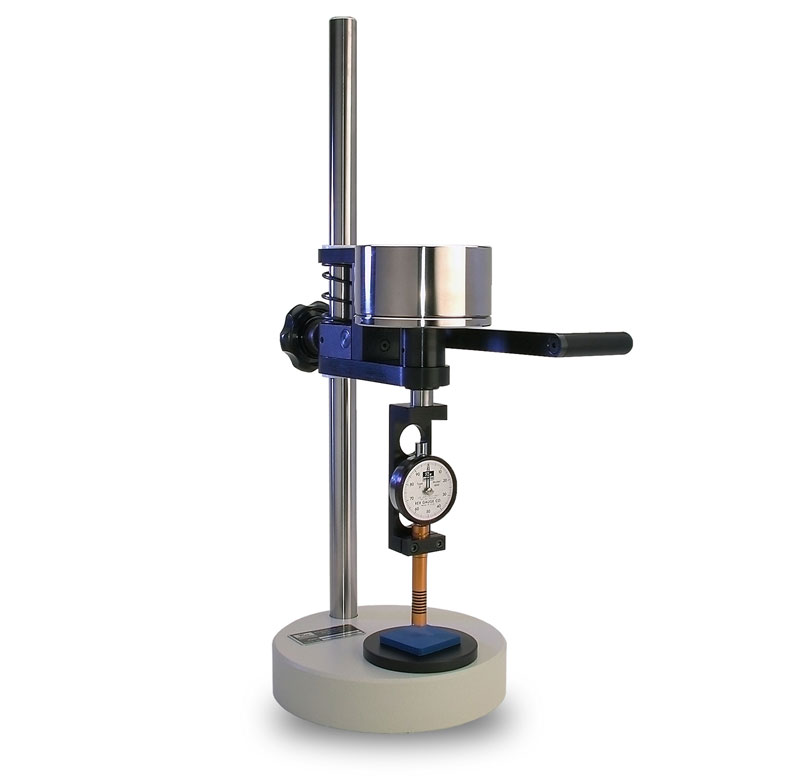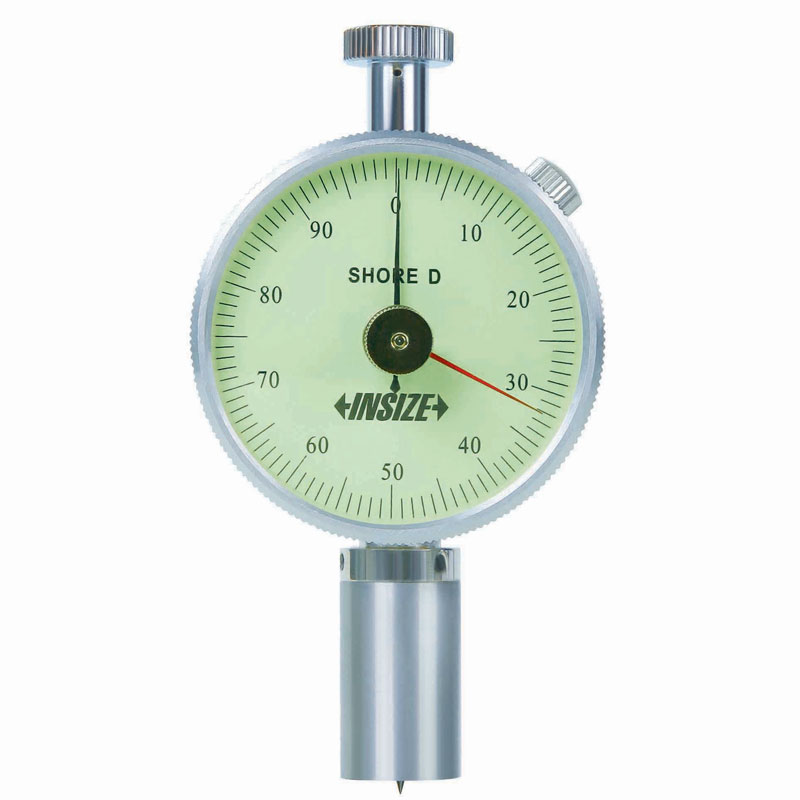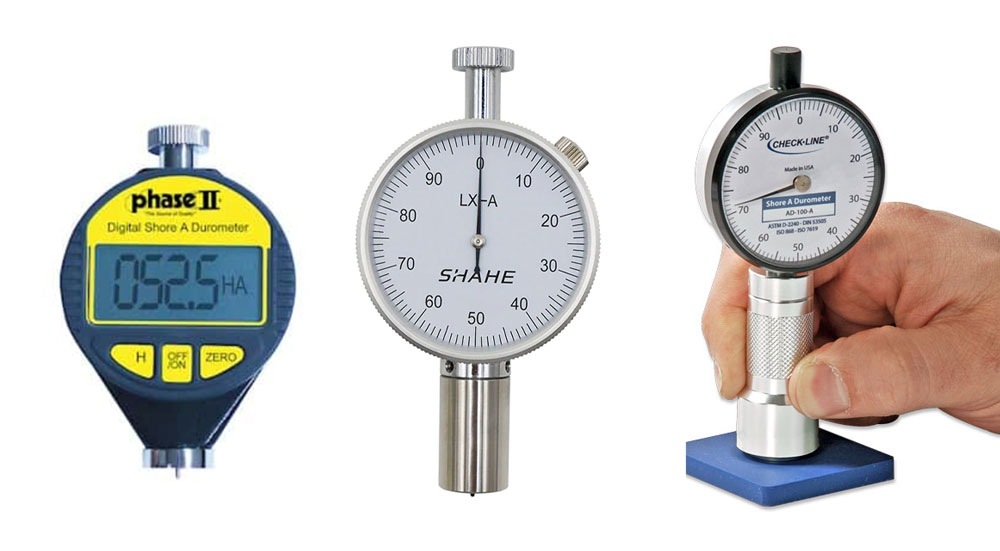Hardness of a material may be something taken for granted by the average person. The difference between your comfortable bike seat and your sturdy nightstand may not mean much to your daily life. However, those in the measurement world understand the nuance that exists between different hardness levels and how that nuance impacts function. In metrology, that nuance has a name—durometer. Most simply, durometer refers to how hard a product is. More abstractly, that hardness can be expressed in terms of relative durometers. Today, we will discuss both the outcome measurement of durometers and the tools used to measure them.
Durometers
Durometers are used to determine the hardness of a particular surface. Hardness refers to how resistant a material is to scratching, cutting, abrasion, or indentation. Measurements of hardness typically abide by the following rule – a higher number means a harder and more durable material, while a lower number means a softer and more flexible material. When working with durometers, the numerical measure of hardness is paired with an alpha scale rating. Different alpha hardness scales exist. The most common hardness scales to explain durometer include Shore OO, Shore A, and Shore D. Shore OO is used for the softest materials and Shore D for the hardest. Each of these scales ranges from 0 to 100, with a higher number translating to a harder material. There is some overlap between each of these scales. Durometers may be used to test the hardness for any material. However, these tools are more commonly used when working with rubber or plastic.
Background of Durometer Standardization
In the 1920, Albert Ferdinand Shore developed a tool to measure material hardness, known as the Shore durometer. Today the Shore durometer is still used and provides a rating of Shore hardness. A compatible harness measurement is known as Rockwell hardness, and refers as well to the resistance a particular material has to indentation. Both Shore hardness and Rockwell hardness can be described using durometers and have a corresponding alpha scale. The major distinctions between the Shore and Rockwell durometers are the materials tested and the alpha scales in use. Rockwell hardness scales are typically chosen when working with harder materials such as nylon, polycarbonate, polystyrene, and acetal. Shore durometers are used when working with rubbers, elastomers, and softer plastics. The common alpha scales for Rockwell durometer are Rockwell E, Rockwell M, and Rockwell R. Whereas the major alpha scales for Shore hardness include Shore OO, Shore A, and Shore D. Choosing one type of durometer over another may come down to preference and tradition. Depending on your location in the world and the industry you work in, you may be more or less familiar with Shore or Rockwell durometers. We will be focusing mainly on the Shore hardness scale.
The American Society for Testing and Materials International (ASTM International) is a standards organization that regulates the agreed upon measurement standards across a range of contexts. Durometer scales coincide with ASTM standards relating to the commonly used alpha scales (A, B, C, D, E, M, O, OO, DO, OOO, OOO-S). You may see material hardness reported using varying terms to describe durometers, using descriptors such as Shore, Rockwell, or a descriptor like extra soft, soft, medium soft, medium hard, hard, or extra hard. In almost all cases, the way in which to interpret the reported hardness involves looking at the number reported (lower means softer) and the alpha scale used. Then consider the particular material and context of the measurement.
An important feature of durometers is their lack of unit of measurement. A durometer is never a standalone measurement unit, but rather is a relative measurement of hardness requiring a comparison between materials. Essentially, the durometer is a dimensionless quality assigned to a material, without a direct relationship between different scales. Therefore, is it very important to know what scale you are using and the rationale behind doing so. Also, remember that hardness of a material does not necessarily relate directly to flexibility. A harder material when quite thin can still bend, whereas a much softer material might be less flexible in thicker portions. Understanding the underlying properties of hardness is important when translating your work to other industries or companies, or determining how your product will function.
Durometer Measurement

Durometer Measurement Gages
Durometer measuring gages are used to take a measurement of durometers. The spring force of a gage increases from Shore OO to Shore D. A pressure foot located on the durometer measuring gage has a point that changes shape depending on the type of durometer scale you are using. The point of the pressure foot gets sharper from Shore OO to Shore D. It is because of the different shapes of the pressure foot as well as the different needed spring force that the main durometer scales overlap to some extent, but not entirely. A material that is very soft requires a Shore OO measuring gage. The same material would be pierced and damaged by the measuring gage intended for measuring durometer using a Shore D scale. Similarly, a material that is very hard requires a Shore D measuring gage. The same material would not even result in a measurement by the measuring gage intended for measuring durometer using a Shore OO scale.
When Taking Durometer Measurements
Whenever you are completing a measurement of durometers, you must keep in mind a few basics requirements in order to have a precise and accurate output. You will need a larger, thicker piece of the material being tested. Typically, you will want a minimum thickness of 6mm and enough width that the measurement can be collected at least 12mm from the edge. Should you require a timed hardness measurement, the particular amount of force will be applied for the determined duration prior to reading the measurement output. Additionally, any materials and samples involved in the measurement ought to be stored in the laboratory climate for at least one hour. This ensures that the physical properties of the materials are as true to form as possible.
Durometer Scales
While there is a small amount of overlap between the three main durometer scales, the way in which they function is for one to pick up where the last one left off. Additionally, a measurement on one durometer scale does not precisely translate to a different measurement on another one. While each scale has a full range from 0 to 100, there are central ranges that focus in on common usage of the scale. The Shore OO scale ranges from about 20 to 60, the Shore A scale ranges from about 5 to 90, and the Shore D scale ranges from about 40 to 85. A material with durometer of 60OO also can be said to have a durometer of 15A and material with a durometer of 90A can also be said to have a durometer of 40D. These conversions concern a bit of durometer gray area and are not a precise translation. In circumstances where there is durometer scale overlap, you can use additional properties of the material to determine the best way in which to report durometer accurately.
Shore OO
The Shore OO scale is used when working with extra soft rubbers. Examples of materials rated using Shore OO durometers include sponge rubber, gummy bears, chewing gum, or the gel insoles of shoes. The typical shape of the pressure foot on a durometer measurement gage when using the Shore OO scale is a conical bottom.
Shore A
The Shore A scale is used when working with soft, medium, and hard rubbers. Examples of materials rated using Shore A durometers include rubber bands, pencil erasers, car tires, polyurethane skateboard wheel, garden hose, or the sole of a shoe. The typical shape of the pressure foot on a durometer measurement gage when using the Shore A scale is a truncated cone.
Shore D
The Shore D scale is used when working with harder materials. Examples of materials rated using Shore D durometers include a shopping cart wheel, ramp-style skateboard wheel, some Tupperware plastics, tape dispenser, and CD cases.

Durometers Matter
The central role of the durometer is to express the hardness of a material and its resistance to possible penetration. Establishment of these qualities is vital to proper design, quality control, and eventual function. Softer versus harder materials serve different roles in different contexts. Harder compounds tend to have a lower friction coefficient, while softer materials when creating a seal on a rough surface. When designing products, understanding the hardness of the required materials is pivotal to have accuracy and precision in creation of the product. Next time you are going about your day, consider how much harness matters in design. Contact the Higher Precision team to learn more about durometers.
FREQUENTLY ASKED QUESTIONS
- How are durometers expressed?
Durometers are expressed using a number and a letter scale. While the specific scale used changes based on the circumstances of the hardness measurement, generally a higher number means a harder and more durable material, while a lower number means a softer and more flexible material. Each numerical rating is then paired with an alpha scale to express what range of hardness is being measured. The main two hardness scales used are the Shore hardness scale and the Rockwell hardness scale. Rockwell scales are often used with harder material measurements, such as nylon or polycarbonate, while the Shore hardness scales are used with rubbers, softer plastics, and elastomers. The common alpha scales for Rockwell durometer are Rockwell E, Rockwell M, and Rockwell R. Whereas the major alpha scales for Shore hardness include Shore OO, Shore A, and Shore D. Which scale is used depends on the material being measured as well as the industry you work in.
- What are the components of a durometer gauge?
There are four central parts to every Shore durometer gauge. First is the pressure foot. The pressure foot is located at the bottom of the gauge, perpendicular to the indentor. Second, the indentor, is a piece that sticks out of the pressure foot. The movement of the indentor during a measurement is what determines the hardness of the material being tested. Third is the calibrated swing. The calibrated swing is attached to the indentor and provides the source of resistance to the movement of the indentor. The accuracy of the calibrated spring has advanced a great deal technologically over the past several years. Finally, every durometer tested has an indicator, which true to its name indicates the hardness of the material at the end of the measurement. Indicators come in both digital and analog display formats.
- How do the different Shore hardness durometer scales interact?
The three main hardness scales are Shore OO, Shore A, and Shore D. The main Shore durometer scales work in tandem, with one scale picking up where the last one left off. With that said, there is some overlap between each scale, but it is important to note that durometers do not translate directly between the different scales. Each scale ranges from 00 to 100, with a more central range representing the most commonly used measurements. The Shore OO scale ranges from about 20 to 60, the Shore A scale ranges from about 5 to 90, and the Shore D scale ranges from about 40 to 85. A material with durometer of 60OO also can be said to have a durometer of 15A and material with a durometer of 90A can also be said to have a durometer of 40D. Again, these are helpful measurement translations to help understand how the scales interact, but whenever you are switching between types of durometer measurement a new measurement must be collected to ensure accuracy. Durometers are a relative measurement and are themselves dimensionless and so conversions between measurements are not a precise translation.
GLOSSARY TERMS
- Durometer
A durometer is a measurement of the hardness of a material, or its resistance to scratching, cutting, abrasion, or indentation. Durometers are expressed using standardized scales that change depending on the hardness of the material, and are defined using a numerical and alpha value. The main two hardness scales used are the Shore hardness scale (Shore OO, Shore A, and Shore D) and the Rockwell hardness scale (Rockwell E, Rockwell M, and Rockwell R). Numerical values for durometers range from 0 to 100, with higher values representing greater hardness.
- Durometer Gauge
A durometer gauge, also known as a durometer tester or just a durometer, is a tool used to measure the durometer of a material. Every durometer gauge consists of a pressure foot, an indentor, a calibrated swing, and an indicator. The shape and size of the pressure foot and the pressure applied by the calibrator switch require adjustment based on the durometer scale being used for measurement and the hardness of the material.

